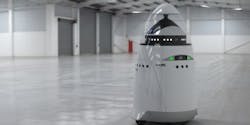A company called Knightscope has developed a mobile robot known as the K5 Autonomous Data Machine as a safety and security guard for corporations, schools, neighborhoods, and so on.
As the New York Times (and anyone who has seen Star Wars) will point out, the robot closely resembles the R2D2 robot from the epic science fiction trilogy. The 300 pound, 5-foot-tall robot will be equipped with a video camera, thermal imaging sensors, a laser range finder, radar, air quality sensors, and a microphone. It will autonomously navigate hallways in preplanned routes in order to provide grounds security.
William Santana Li, co-founder of the company, said in the Times article that the robot was developed after the events of the Sandy Hook tragedy. The robots would be wirelessly connected to a centralized server with access to "big data," – enabling them to perform facial recognition and optical character recognition technology for security purposes. While the robots could provide an added level of security and safety, the New York Times raises some interesting points about its potential usage.
First is the question of jobs. If a robot is performing the job of a security guard, then what would happen to the current security guard? Sure, if an institution or place of business does not currently utilize security, but opts for the K5 robot, then sure, I suppose there is no harm done. However, if a school or business replaces a human security officer with the cheaper option robot, then jobs would effectively be eliminated, which is a proposition that is likely to be unappealing to many, namely, those in the security field.
To address this, Li and his team suggest that the robots could perform the strategic work and control a "herd of security robots," in a given setting. Essentially, the robots would work in tandem with humans instead of replacing them.
Second is the issue of privacy. Like UAVs or drones, many people may call into question the implications that these all-seeing robots may have on privacy. Specifically, making sensor and other data public, which the robot would do, could prove to be an issue, according to VentureBeat. In an interview, Li said the data will live stream to the community and to authorities with full transparency. In addition, he said that the privacy provided by the robots would be similar to that of entering a department store, using an ATM, or purchasing something at a local convenience store.
When it comes to things that may or may not invade people’s privacy like these robots or a UAV, it seems that someone will always take issue. Personally I am not sure which side of the fence I fall on. But if these robots were to be deployed in a school, mall, or other place of business, and it can be shown that they have in fact deterred crime in some way, well then I would think it may be a bit harder to present an argument against them.
What do you think? Are these robots a good idea, or are they going too far when it comes to the invasion of privacy? I am interested to see what you think. Let us know by leaving a comment below.
About the Author

James Carroll
Former VSD Editor James Carroll joined the team 2013. Carroll covered machine vision and imaging from numerous angles, including application stories, industry news, market updates, and new products. In addition to writing and editing articles, Carroll managed the Innovators Awards program and webcasts.
